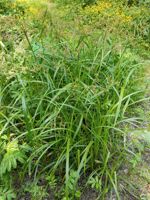Mon-Fri 9am - 5pm Mountain time
Bluebunch Wheatgrass vs Panicled Bulrush
Pseudoroegneria spicata (Agropyron spicatum)
Scirpus microcarpus
CUSTOM GROW
CUSTOM GROW
Bluebunch Wheatgrass is a native perennial bunchgrass common across prairies, foothills, and open woodlands. Longer-lived than many other grass species, it develops deep, fibrous roots that stabilize soils and make it drought-tolerant once established. It is a cool-season grass, growing most actively in spring and fall and slowing during the heat of summer.
This hardy grass provides excellent forage for deer, elk, and bighorn sheep, and is especially palatable to livestock. Its seeds feed birds and small mammals, while its bunching growth offers protective cover for ground-nesting birds such as sparrows and sage-grouse, as well as shelter for small mammals. Bluebunch Wheatgrass is well-suited to rangeland & prairie restoration, naturalization, and erosion control projects.
Panicled Bulrush is a native perennial sedge that thrives in saturated soils and shallow water. Spreading readily by rhizomes, it quickly forms tall clumps that make it especially valuable for riparian plantings, erosion control, ecological restoration, and naturalization projects.
Its many-branched clusters of small flower heads give the plant its name and add texture to wetland landscapes. In addition to stabilizing shorelines and improving habitat quality, Panicled Bulrush provides food and cover for waterfowl, small mammals, and other wildlife. A cool-season grower, it is most active in spring and fall, slowing or going dormant during the heat of summer.

